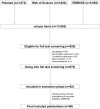Systematic review of guidelines for internal validity in the design, conduct and analysis of preclinical biomedical experiments involving laboratory animals
- PMID: 35047688
- PMCID: PMC8647591
- DOI: 10.1136/bmjos-2019-100046
Systematic review of guidelines for internal validity in the design, conduct and analysis of preclinical biomedical experiments involving laboratory animals
Abstract
Over the last two decades, awareness of the negative repercussions of flaws in the planning, conduct and reporting of preclinical research involving experimental animals has been growing. Several initiatives have set out to increase transparency and internal validity of preclinical studies, mostly publishing expert consensus and experience. While many of the points raised in these various guidelines are identical or similar, they differ in detail and rigour. Most of them focus on reporting, only few of them cover the planning and conduct of studies. The aim of this systematic review is to identify existing experimental design, conduct, analysis and reporting guidelines relating to preclinical animal research. A systematic search in PubMed, Embase and Web of Science retrieved 13 863 unique results. After screening these on title and abstract, 613 papers entered the full-text assessment stage, from which 60 papers were retained. From these, we extracted unique 58 recommendations on the planning, conduct and reporting of preclinical animal studies. Sample size calculations, adequate statistical methods, concealed and randomised allocation of animals to treatment, blinded outcome assessment and recording of animal flow through the experiment were recommended in more than half of the publications. While we consider these recommendations to be valuable, there is a striking lack of experimental evidence on their importance and relative effect on experiments and effect sizes.
Keywords: animal studies; bias; internal validity; preclinical studies; scientific rigor.
© Author(s) (or their employer(s)) 2020. Re-use permitted under CC BY. Published by BMJ.
Conflict of interest statement
Competing interests: None declared.
Figures
References
LinkOut - more resources
Full Text Sources

